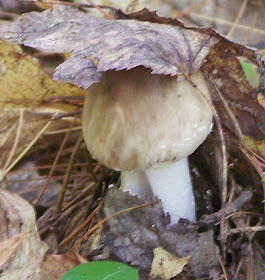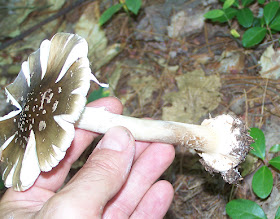 |
| Cleft-foot Amanita in a mixed deciduous- coniferous wood with many oak trees. Photo by Brad Sylvester, copyright 2011 Do not copy. |
To start with, I photographed a mushroom in various states of growth as there were several of the same species present. I lifted one out of the ground to look at the base. I photographed the stalk and the underside of the cap. I noted the type of ground and vegetation around it. I thought I had all the bases covered. I was wrong.
For many species of mushrooms, it may be necessary to 1) bruise the mushroom stalk to see if the bruise discolors and if so what color it turns. 2) slice the gills and see if they exude a latex and, if they do, what color it is, and if it changes color after exposure to air. 3) take a spore print and see the color of the spores. A microscopic examination of the spores can also provide an identification key, although that would rarely, if ever, be needed.
In this case, however, I got lucky and believe I have a good identification using the National Audubon Society Field Guide to North American Mushrooms
 . The mushroom specimen pictured here appears to be the cleft-foot amanita (Amanita brunnescens). A species listed as "possibly poisonous," but closely related (and similar in appearance) to some very seriously poisonous Amanita mushrooms. How did I get to that conclusion? Let's go through the steps.
. The mushroom specimen pictured here appears to be the cleft-foot amanita (Amanita brunnescens). A species listed as "possibly poisonous," but closely related (and similar in appearance) to some very seriously poisonous Amanita mushrooms. How did I get to that conclusion? Let's go through the steps. |
| The vertical split is clearly visible in this specimen of Cleft-foot Amanita. Photo by Brad Sylvester, copyright 2011. |
Then we run down the other field marks or identification keys for this species. Dark brown to whitish at the margin, check. Patches left over from the universal veil on the top of the cap, check. A collapsing pendant ring (looks like a skirt of skin-like tissue) around the mid or upper stalk, check. Large, bulbous base with an abrupt start from the stalk, check. Gills are free (meaning that the gills are not attached to the central stalk), check. The base has a distinct vertical cleft or split, check. Season: July- October, check. Grows on dry ground among deciduous trees, especially oak, check. Flesh is white, check. Bruises to reddish-brown, unknown (although there is some brownish discoloration where the stalk has been subject to normal wear). Spore print is white, unknown.
 |
| The gills and collapsed pendant ring of the cleft-foot amanita Photo by Brad Sylvester, copyright 2011 |
 |
| The bulbous base of the Cleft-foot Amanita begins abruptly Photo by Brad Sylvester, copyright 2011 |
Casinos with Slots and Casino Games - The JTM Hub
ReplyDeleteCasinos with Slots and Casino Games · Casinos with Casino Games · 김천 출장안마 Casinos with Casino 전라북도 출장샵 Games 논산 출장마사지 · Slots and Casino Games · Slots and Casino 대전광역 출장샵 Games 동두천 출장마사지 · Slots and Casino Games · Slots and